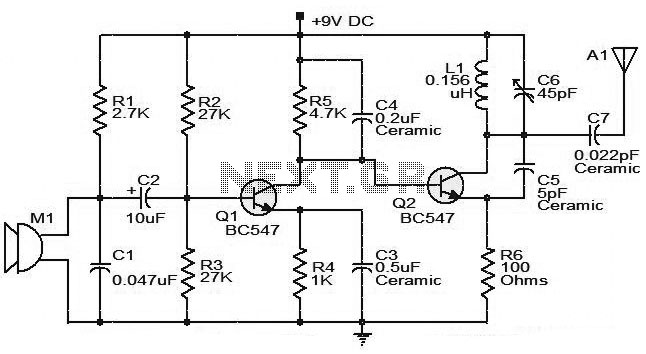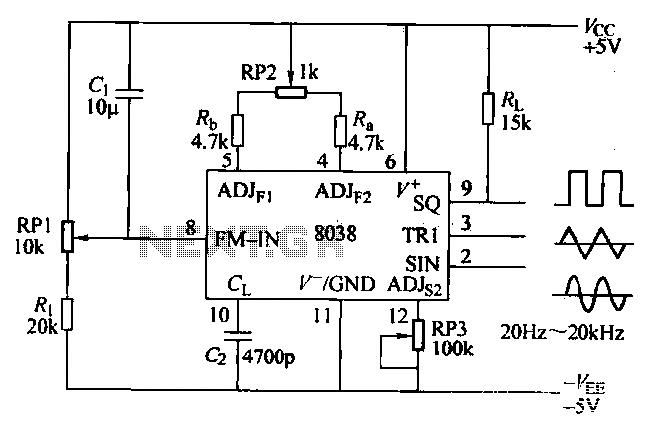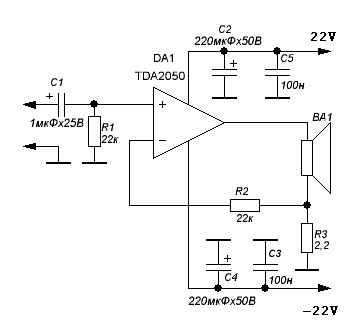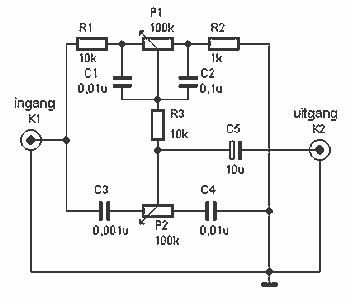
30 Watt Audio Power Amplifier
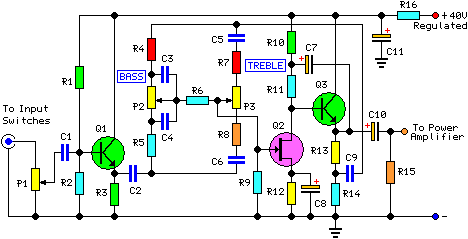
This project involved the design of an audio amplifier capable of delivering substantial output power with minimal component count while maintaining high quality. The power amplifier section utilizes three transistors along with a few resistors and capacitors in a shunt feedback configuration, achieving over 18W into an 8 Ohm load with 0.08% total harmonic distortion (THD) at 1KHz at the clipping onset (0.04% THD at 1W - 1KHz and 0.02% THD at 1W - 10KHz), and up to 30W into a 4 Ohm load. To achieve this performance and ensure the stability of the simple circuitry, a regulated DC power supply is essential. This requirement is beneficial as it helps maintain low noise and hum levels in the preamp and guarantees predictable output power across varying load impedances. The amplifier operates on a single rail supply, allowing for the implementation of a DC voltage regulator that can provide over 2 Amps at 40V with minimal components. For testing, the supply should be switched off, and a multimeter should be connected to measure at least 1 Amp in series with the positive supply; using a second multimeter for this purpose is advisable. Those with access to an oscilloscope and a 1KHz sine wave generator can push the amplifier to its maximum output power and adjust R3 to achieve symmetrical clipping of the displayed sine wave. The preamp sensitivity and overload margin are designed to accommodate most modern audio sources, such as CD players, tape recorders, iPods, computer audio outputs, and tuners. The arrangement and number of source selecting switches and input connectors are left to the constructor's discretion. To achieve a high input overload margin, the volume control is placed at the preamp input. Following a unity gain impedance converter stage (Q1), a negative-feedback Baxandall-type bass and treble tone control stage is included. This stage provides a gain of approximately 5.6 times and employs a low-noise, bootstrapped two-transistor circuit with FET input, resulting in excellent THD figures at up to 4V RMS output and a low output impedance suitable for driving the Mini-MosFet power amplifier, as well as other applications. The regulated power supply section is enhanced by adding a PNP power transistor to the LM317T adjustable regulator chip, enabling the circuit to deliver significantly more power than needed to drive two Mini-MosFet amplifiers to full output (at least 2 Amps at 40V into a 4 Ohm load) without difficulty. A power transformer with a secondary winding rated at 35-36V and 50VA (approximately 1.4 Amps) is required for 8 Ohm nominal impedance loudspeaker cabinets. For driving 4 Ohm loads at high power levels, a transformer rated at 70-75VA (at least 2 Amps) is recommended. These transformers are typically center-tapped, with the central lead left open. In a stereo version of this project, R16 and C11 in the preamp will be shared between both channels, requiring only one of each component; R16 should be a 1.5K 1/2W resistor, while the value of C11 remains unchanged.
The audio amplifier circuit is designed for simplicity and efficiency, utilizing a minimal number of components to achieve high performance. The core of the amplifier is the power amplifier section, which is based on a three-transistor configuration that allows for efficient amplification of audio signals. The shunt feedback configuration enhances linearity and reduces distortion, contributing to the overall sound quality.
The regulated power supply is critical for maintaining stable operation and minimizing noise. The LM317T adjustable regulator is a versatile component that, when augmented with a PNP transistor, can effectively handle the current demands of the amplifier. This configuration ensures that the amplifier can deliver consistent performance even under varying load conditions.
The preamp stage is designed with flexibility in mind, featuring a volume control at the input to maximize the input overload margin. The Baxandall-type tone control stage allows users to tailor the audio output to their preferences, enhancing the listening experience. The use of a bootstrapped circuit design in this stage ensures low noise and high fidelity, making it suitable for a wide range of audio sources.
Overall, this audio amplifier project exemplifies a balance between minimalism and performance, allowing for a high-quality audio experience with a straightforward design approach. The careful selection of components and configuration ensures that the amplifier can meet the demands of modern audio playback while remaining accessible to constructors with varying levels of expertise.This project was a sort of challenge: designing an audio amplifier capable of delivering a decent output power with a minimum parts count, without sacrificing quality. The Power Amplifier section employs only three transistors and a handful of resistors and capacitors in a shunt feedback configuration but can deliver more than 18W into 8 Ohm with
0. 08% THD @ 1KHz at the onset of clipping (0. 04% @ 1W - 1KHz and 0. 02% @ 1W - 10KHz) and up to 30W into a 4 Ohm load. To obtain such a performance and to ensure overall stability of this very simple circuitry, a suitable regulated dc power supply is mandatory. This is not a snag because it also helps in keeping noise and hum of the preamp to very low levels and guarantees a predictable output power into different load impedance.
Finally, as the amplifier requires only a single rail supply, a very good dc voltage regulator capable of supplying more than 2 Amps @ 40V can be implemented with a few parts also. Switch off the supply, disconnect the Multimeter and reconnect it, set to measure at least 1Amp fsd, in series to the positive supply (the possible use of a second Multimeter in this place will be very welcomed).
Those lucky enough to reach an oscilloscope and a 1KHz sine wave generator, can drive the amplifier to the maximum output power and adjust R3 in order to obtain a symmetrical clipping of the sine wave displayed. The Preamp sensitivity and overload margin were designed to cope with most modern music program sources like CD players, Tape recorders, iPods, Computer audio outputs, Tuners etc.
The source selecting switches and input connectors are not shown and their number and arrangement are left to the constructor`s choice. To obtain a very high input overload margin, the volume control was placed at the preamp input. After a unity gain, impedance converter stage (Q1) a negative-feedback Baxandall-type Bass and Treble tone control stage was added.
As this stage must provide some gain (about 5. 6 times) a very low noise, "bootstrapped" two-transistors circuitry with FET-input was implemented. This stage features also excellent THD figures up to 4V RMS output and a low output impedance, necessary to drive properly the Mini-MosFet Power Amplifier, but can also be used for other purposes. A very good and powerful Regulated Power Supply section was implemented by simply adding a PNP power transistor to the excellent LM317T adjustable regulator chip.
In this way this circuit was able to deliver much more than the power required to drive two Mini-MosFet amplifiers to full output (at least 2Amp @ 40V into 4 Ohm load) without any appreciable effort. A power Transformer having a secondary winding rated at 35 - 36V and 50VA (i. e. about 1. 4Amp) is required if you intend to use Loudspeaker cabinets of 8 Ohm nominal impedance. To drive 4 Ohm loads at high power levels, a 70 - 75VA Transformer (2Amp at least) will be a better choice.
These transformers are usually center tapped: the central lead will be obviously left open. For the stereo version of this project, R16 and C11 in the Preamp will be in common to both channels: therefore, only one item each is necessary. In this case, R16 must be a 1K5 1/2W resistor. The value of C11 will remain unchanged. 🔗 External reference
The audio amplifier circuit is designed for simplicity and efficiency, utilizing a minimal number of components to achieve high performance. The core of the amplifier is the power amplifier section, which is based on a three-transistor configuration that allows for efficient amplification of audio signals. The shunt feedback configuration enhances linearity and reduces distortion, contributing to the overall sound quality.
The regulated power supply is critical for maintaining stable operation and minimizing noise. The LM317T adjustable regulator is a versatile component that, when augmented with a PNP transistor, can effectively handle the current demands of the amplifier. This configuration ensures that the amplifier can deliver consistent performance even under varying load conditions.
The preamp stage is designed with flexibility in mind, featuring a volume control at the input to maximize the input overload margin. The Baxandall-type tone control stage allows users to tailor the audio output to their preferences, enhancing the listening experience. The use of a bootstrapped circuit design in this stage ensures low noise and high fidelity, making it suitable for a wide range of audio sources.
Overall, this audio amplifier project exemplifies a balance between minimalism and performance, allowing for a high-quality audio experience with a straightforward design approach. The careful selection of components and configuration ensures that the amplifier can meet the demands of modern audio playback while remaining accessible to constructors with varying levels of expertise.This project was a sort of challenge: designing an audio amplifier capable of delivering a decent output power with a minimum parts count, without sacrificing quality. The Power Amplifier section employs only three transistors and a handful of resistors and capacitors in a shunt feedback configuration but can deliver more than 18W into 8 Ohm with
0. 08% THD @ 1KHz at the onset of clipping (0. 04% @ 1W - 1KHz and 0. 02% @ 1W - 10KHz) and up to 30W into a 4 Ohm load. To obtain such a performance and to ensure overall stability of this very simple circuitry, a suitable regulated dc power supply is mandatory. This is not a snag because it also helps in keeping noise and hum of the preamp to very low levels and guarantees a predictable output power into different load impedance.
Finally, as the amplifier requires only a single rail supply, a very good dc voltage regulator capable of supplying more than 2 Amps @ 40V can be implemented with a few parts also. Switch off the supply, disconnect the Multimeter and reconnect it, set to measure at least 1Amp fsd, in series to the positive supply (the possible use of a second Multimeter in this place will be very welcomed).
Those lucky enough to reach an oscilloscope and a 1KHz sine wave generator, can drive the amplifier to the maximum output power and adjust R3 in order to obtain a symmetrical clipping of the sine wave displayed. The Preamp sensitivity and overload margin were designed to cope with most modern music program sources like CD players, Tape recorders, iPods, Computer audio outputs, Tuners etc.
The source selecting switches and input connectors are not shown and their number and arrangement are left to the constructor`s choice. To obtain a very high input overload margin, the volume control was placed at the preamp input. After a unity gain, impedance converter stage (Q1) a negative-feedback Baxandall-type Bass and Treble tone control stage was added.
As this stage must provide some gain (about 5. 6 times) a very low noise, "bootstrapped" two-transistors circuitry with FET-input was implemented. This stage features also excellent THD figures up to 4V RMS output and a low output impedance, necessary to drive properly the Mini-MosFet Power Amplifier, but can also be used for other purposes. A very good and powerful Regulated Power Supply section was implemented by simply adding a PNP power transistor to the excellent LM317T adjustable regulator chip.
In this way this circuit was able to deliver much more than the power required to drive two Mini-MosFet amplifiers to full output (at least 2Amp @ 40V into 4 Ohm load) without any appreciable effort. A power Transformer having a secondary winding rated at 35 - 36V and 50VA (i. e. about 1. 4Amp) is required if you intend to use Loudspeaker cabinets of 8 Ohm nominal impedance. To drive 4 Ohm loads at high power levels, a 70 - 75VA Transformer (2Amp at least) will be a better choice.
These transformers are usually center tapped: the central lead will be obviously left open. For the stereo version of this project, R16 and C11 in the Preamp will be in common to both channels: therefore, only one item each is necessary. In this case, R16 must be a 1K5 1/2W resistor. The value of C11 will remain unchanged. 🔗 External reference
